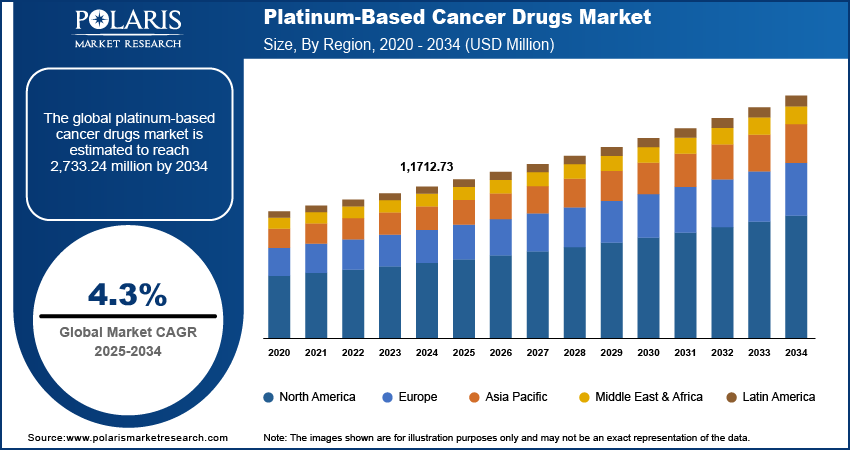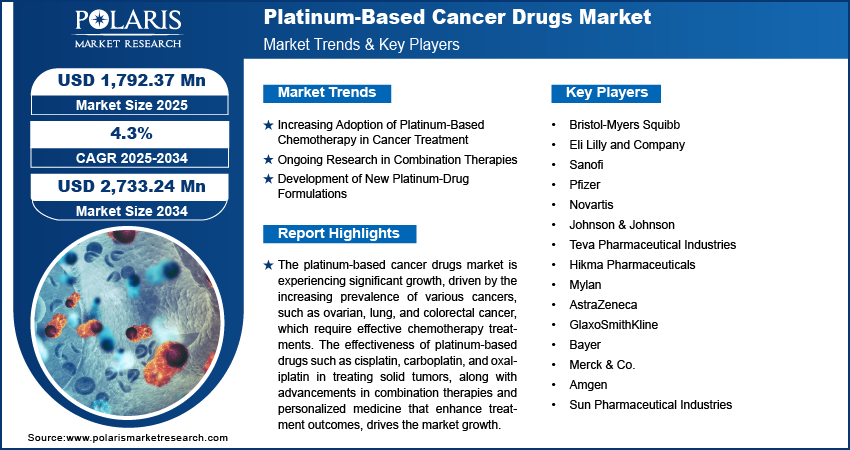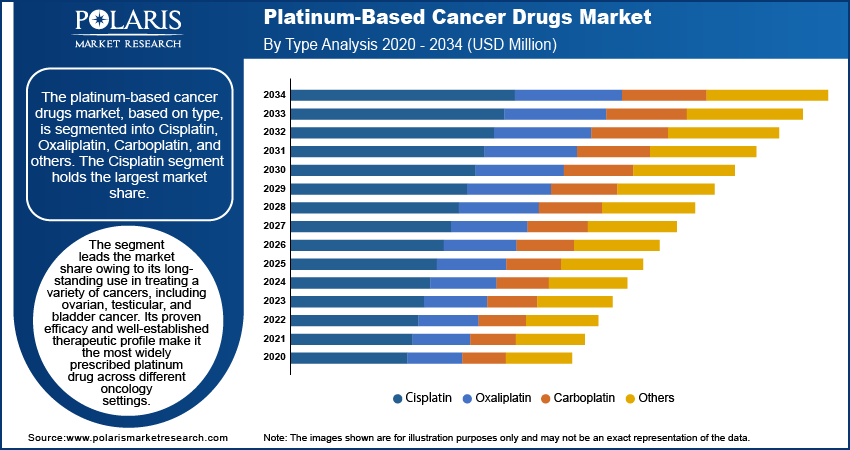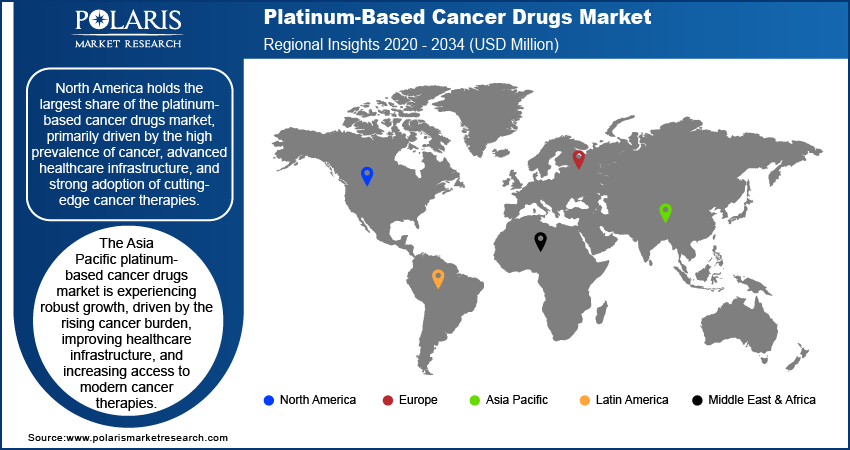
Platinum-Based Cancer Drugs Market Size, Share, Trends, Industry Analysis Report: By Type (Cisplatin, Oxaliplatin, Carboplatin, and Others), Application, Distribution Channel, and Region (North America, Europe, Asia Pacific, Latin America and Middle, East & Africa) – Market Forecast, 2025–2034
- Published Date:Dec-2024
- Pages: 118
- Format: PDF
- Report ID: PM1635
- Base Year: 2024
- Historical Data: 2020-2023
Platinum-Based Cancer Drugs Market Overview
The global platinum-based cancer drugs market size was valued at USD 1,712.73 million in 2024. The market is projected to grow from USD 1,792.37 million in 2025 to USD 2,733.24 million by 2034, exhibiting a CAGR of 4.3% during 2025–2034.
The global platinum-based cancer drugs market refers to the segment of the pharmaceutical industry that focuses on the development, production, and distribution of chemotherapy treatments using platinum compounds, such as cisplatin, carboplatin, and oxaliplatin, to treat various types of cancer. These drugs are primarily used in the treatment of solid tumors, including ovarian, lung, and testicular cancers. A few key drivers of market growth include the increasing prevalence of cancer, advancements in drug formulations, and the growing adoption of platinum-based therapies due to their effectiveness in improving survival rates. Additionally, trends such as the rising demand for personalized medicine, ongoing research into combination therapies, and the development of more targeted treatments are expected to shape the market's future. The platinum-based cancer drugs market demand is also driven by government support, healthcare infrastructure improvements, and growing awareness about cancer prevention and treatment.

To Understand More About this Research: Request a Free Sample Report
Platinum-Based Cancer Drugs Market Dynamics
Increasing Adoption of Platinum-Based Chemotherapy in Cancer Treatment
Platinum-based chemotherapy continues to be a standard treatment for various cancers, particularly solid tumors such as lung, ovarian, and testicular cancers. The adoption of these drugs has been significantly driven by their proven effectiveness in improving survival rates, particularly for cancers that are difficult to treat. For example, cisplatin, one of the most commonly used platinum drugs, has shown high efficacy in the treatment of advanced ovarian cancer, which contributes to its ongoing widespread use. As per the American Cancer Society, over 300,000 women worldwide are diagnosed with ovarian cancer annually, many of whom receive platinum-based therapies as part of their treatment plan. The increasing prevalence of cancer cases, along with the rising awareness and access to advanced chemotherapy treatments, continues to drive the use of platinum-based drugs in clinical settings.
Ongoing Research in Combination Therapies
A major trend in the platinum-based cancer drugs market is the growing interest in combination therapies, where platinum compounds are combined with other chemotherapy agents, targeted therapies, or immunotherapies. This approach aims to enhance the therapeutic outcomes, reduce side effects, and overcome the development of resistance, a common challenge in chemotherapy. Research has demonstrated that combining platinum-based drugs such as cisplatin with other agents, such as paclitaxel or pembrolizumab, can significantly improve treatment efficacy. For example, clinical trials have shown that the combination of carboplatin and paclitaxel has a better overall response rate in ovarian cancer compared to using either drug alone. With the rise of immuno-oncology treatments and targeted therapies, platinum drugs are being explored in various clinical trials as part of combination regimens. This platinum-based cancer drugs market trend is expected to expand as research uncovers more synergistic treatment possibilities.
Development of New Platinum-Drug Formulations
The platinum-based cancer drugs market is witnessing significant innovations in the development of new formulations of platinum-based drugs to reduce their side effects and improve patient outcomes. Traditional platinum drugs such as cisplatin are known to cause severe side effects, including nephrotoxicity, neurotoxicity, and gastrointestinal problems, limiting their use in many cases. Newer formulations, such as liposomal platinum compounds, aim to improve drug delivery to cancer cells while minimizing damage to healthy tissue. For example, liposomal cisplatin (a formulation that encapsulates cisplatin in a lipid layer) has shown promising results in clinical trials, offering enhanced drug stability and reduced side effects. Additionally, researchers are focusing on developing targeted delivery systems that can precisely direct the drug to tumor sites, thereby increasing treatment efficacy and minimizing systemic toxicity. These advances are expected to contribute significantly to the platinum-based cancer drugs market development as they address the long-standing challenges of toxicity and treatment resistance.

Platinum-Based Cancer Drugs Market Segment Insights
Platinum-Based Cancer Drugs Market Outlook – Type-Based Insights
The platinum-based cancer drugs market, based on type, is segmented into Cisplatin, Oxaliplatin, Carboplatin, and others. The Cisplatin segment holds the largest market share, owing to its long-standing use in treating a variety of cancers, including ovarian, testicular, and bladder cancer. Its proven efficacy and well-established therapeutic profile make it the most widely prescribed platinum drug across different oncology settings. Carboplatin, another significant drug in the market, is gaining traction due to its reduced side-effect profile compared to cisplatin, making it a preferred option for patients affected by compromised renal function. Oxaliplatin, primarily used in the treatment of colorectal cancer, is also experiencing strong growth, especially with the increasing incidence of colorectal cancers globally. The others segment, which includes experimental formulations and combinations, is registering notable growth, driven by the ongoing development of new formulations that offer improved therapeutic outcomes and reduced side effects, such as liposomal platinum-based drugs and combination therapies with targeted agents.
The oxaliplatin segment is showing the highest growth rate, fueled by the increasing cases of colorectal cancer and the expanding indications for its use in combination therapies. With the rise in personalized treatment approaches and combination regimens, oxaliplatin's use in clinical practice is expected to continue its upward trajectory. Cisplatin remains the dominant player in terms of market value due to its established role in treating multiple cancer types. However, the increasing focus on minimizing toxicity and enhancing treatment regimens positions other platinum drugs, especially oxaliplatin and carboplatin, as key growth drivers in the market. The ongoing clinical research into more effective drug formulations further supports the growth of these segments.
Platinum-Based Cancer Drugs Market Assessment – Application-Based Insights
The platinum-based cancer drugs market, by application, is segmented into colorectal cancer, ovarian cancer, lung cancer, and others. The ovarian cancer segment holds the largest market share due to the high efficacy of platinum-based drugs, particularly cisplatin and carboplatin, in treating this type of cancer. The established use of platinum compounds in first-line and recurrent ovarian cancer therapies has cemented its position as a primary application area. Colorectal cancer is another significant application, driven by the widespread use of oxaliplatin in chemotherapy regimens, particularly in adjuvant settings and advanced stages. The growth of the colorectal cancer segment is also supported by the increasing prevalence of this cancer globally and the expanded use of platinum-based therapies in combination with other agents for improved outcomes.
The lung cancer segment is registering the highest growth, primarily due to the increasing incidence of non-small cell lung cancer (NSCLC), where platinum-based treatments, especially cisplatin and carboplatin, are central to standard chemotherapy regimens. Lung cancer's growing global prevalence, along with advancements in combination therapies, has significantly contributed to this segment's rapid expansion. While other cancers, such as breast, head, and neck cancers, are also relevant for platinum drugs, they are generally less significant in the market compared to the major applications. The increasing adoption of combination therapies and the exploration of platinum drugs in clinical trials for other cancer types further support the overall growth across these applications.
Platinum-Based Cancer Drugs Market Evaluation – Distribution Channel-Based Insights
The platinum-based cancer drugs market, by distribution channel, is segmented into hospital-based pharmacies, retail pharmacies, and online pharmacies. The hospital-based pharmacies segment dominates the market in terms of share, as they are the primary source for cancer patients requiring chemotherapy treatments, which are often administered under direct medical supervision. These pharmacies provide a crucial service in the management and dispensation of platinum-based drugs, especially for inpatient treatments or chemotherapy regimens that require specialized care. Hospitals also offer a comprehensive range of cancer care services, making them the most significant distribution channel for platinum drugs, particularly for those requiring intravenous administration or complex therapeutic monitoring.
The online pharmacies segment is registering the highest growth, driven by the increasing trend of digital healthcare and the growing preference for home-based care. The convenience and accessibility of online pharmacies, combined with the expanding shift toward telemedicine and e-prescriptions, have contributed to the rise of this channel. Patients can now access prescription medications, including platinum-based drugs, more easily through online platforms, especially for follow-up treatments or outpatient care. This trend is further driven by the growth of healthcare delivery models that emphasize remote consultations and home healthcare, where online pharmacies play a key role in ensuring timely and efficient access to necessary medications.

Platinum-Based Cancer Drugs Market Regional Insights
By region, the study provides platinum-based cancer drugs market insights into North America, Europe, Asia Pacific, Latin America, and the Middle East & Africa. North America holds the largest share of the platinum-based cancer drugs market revenue, primarily driven by the high prevalence of cancer, advanced healthcare infrastructure, and strong adoption of cutting-edge cancer therapies. The region benefits from well-established healthcare systems, widespread access to platinum-based chemotherapy treatments, and significant investments in cancer research and development. The US, in particular, is a major contributor due to its robust pharmaceutical industry, high cancer incidence rates, and extensive platinum-based drugs use in oncology clinics and hospitals. Additionally, government support for cancer care programs and the increasing number of clinical trials in the region further reinforce North America's dominant position in the global market. Other regions, such as Europe and Asia Pacific, also contribute significantly but face different challenges, such as varying healthcare access and economic conditions, which impact their overall market share.
Europe holds a significant share in the platinum-based cancer drugs market, driven by the high prevalence of cancer and the presence of advanced healthcare systems across the region. Countries such as Germany, France, and the UK are major contributors due to their well-established cancer treatment infrastructures and access to innovative therapies. The use of platinum-based drugs such as cisplatin and oxaliplatin in treating various cancers, particularly ovarian and colorectal cancer, remains widespread. Additionally, government initiatives and healthcare programs to improve cancer care and early detection have supported the market's growth. However, regional disparities in healthcare access and affordability, particularly in Eastern Europe, may impact the overall market penetration in certain areas.
The Asia Pacific platinum-based cancer drugs market is experiencing robust growth, driven by the rising cancer burden, improving healthcare infrastructure, and increasing access to modern cancer therapies. Countries such as China, Japan, and India are seeing a significant increase in the demand for platinum-based chemotherapy due to the growing prevalence of cancers, such as lung and colorectal cancers, and greater adoption of these therapies in urban and rural areas. Japan leads the market in terms of healthcare sophistication and pharmaceutical access, while China and India are expanding rapidly due to improving healthcare systems and rising healthcare spending. However, challenges such as healthcare affordability, access to newer drugs, and lack of awareness about cancer treatment options hinder the market’s overall growth potential in some parts of the region.

Platinum-Based Cancer Drugs Market – Key Players and Competitive Insights
The platinum-based cancer drugs market includes several prominent pharmaceutical companies that develop, manufacture, and distribute platinum-based compounds used in chemotherapy treatments. A few key players in the market are Bristol-Myers Squibb, Eli Lilly and Company, Sanofi, Pfizer, Novartis, Johnson & Johnson, Teva Pharmaceutical Industries, Hikma Pharmaceuticals, Mylan, AstraZeneca, GlaxoSmithKline, Bayer, Merck & Co., Amgen, and Sun Pharmaceutical Industries. These companies are actively involved in the production of platinum drugs such as cisplatin, carboplatin, and oxaliplatin, which are used for the treatment of various cancers. A few companies, such as Pfizer and Sanofi, also focus on researching new formulations or combination therapies to improve the efficacy and safety of these drugs.
In terms of competition, pharmaceutical companies are focused on enhancing drug delivery systems and reducing the side effects commonly associated with platinum drugs. AstraZeneca and Johnson & Johnson are investing in the development of combination therapies, which often pair platinum drugs with other agents to improve treatment outcomes. Additionally, firms such as Teva Pharmaceutical Industries and Mylan are increasingly involved in the production of generic versions of platinum-based drugs, aiming to offer more affordable options in markets with significant cost sensitivity. Companies such as Merck & Co. and Amgen are also working on innovative formulations and alternative delivery systems, including liposomal versions and targeted therapies, to differentiate their products in the competitive landscape.
The platinum-based cancer drugs market is evolving with these companies and addressing the increasing need for personalized treatment approaches. As oncology becomes more targeted, companies are focusing on drugs that can be tailored to the genetic profiles of tumors, as well as improving patient adherence and minimizing side effects. Sun Pharmaceutical Industries has been active in exploring advanced formulations and is investing in expanding its presence in emerging markets such as India, where the demand for affordable cancer treatments is rising. While the competitive landscape is dominated by large pharmaceutical firms with substantial resources, there is a growing emphasis on innovation, affordability, and improving patient outcomes, which are shaping the future dynamics of the platinum-based cancer drugs market.
Bristol-Myers Squibb is a global pharmaceutical company known for its strong presence in the oncology sector, including the development and distribution of platinum-based cancer drugs. The company’s portfolio includes products such as cisplatin, used in various cancer therapies. Bristol-Myers Squibb has a history of working on innovative cancer treatments and is involved in the research and development of new formulations that aim to improve the effectiveness of platinum drugs while reducing side effects.
Pfizer is another major player in the platinum-based cancer drugs market, with a range of products, including cisplatin and carboplatin, for various types of cancers. Pfizer is actively involved in the development of new chemotherapy drugs and improving existing ones, with a focus on patient outcomes and reducing treatment-related toxicity. The company has also been working on expanding access to cancer treatments in emerging markets.
List of Key Companies in Platinum-Based Cancer Drugs Market
- Bristol-Myers Squibb
- Eli Lilly and Company
- Sanofi
- Pfizer
- Novartis
- Johnson & Johnson
- Teva Pharmaceutical Industries
- Hikma Pharmaceuticals
- Mylan
- AstraZeneca
- GlaxoSmithKline
- Bayer
- Merck & Co.
- Amgen
- Sun Pharmaceutical Industries
Platinum-Based Cancer Drugs Industry Developments
- In October 2024, Bristol-Myers Squibb announced that it had received regulatory approval for a combination therapy involving one of its platinum-based drugs, marking a step forward in its oncology portfolio.
- In September 2024, Pfizer announced the successful completion of a late-stage clinical trial for a new formulation of carboplatin, showing promising results in increasing efficacy for certain types of cancer.
Platinum-Based Cancer Drugs Market Segmentation
By Type Outlook
- Cisplatin
- Oxaliplatin
- Carboplatin
- Others
By Application Outlook
- Colorectal Cancer
- Ovarian Cancer
- Lung Cancer
- Others
By Distribution Channel Outlook
- Hospital-Based Pharmacies
- Retail Pharmacies
- Online Pharmacies
By Regional Outlook
- North America
- US
- Canada
- Europe
- Germany
- France
- UK
- Italy
- Spain
- Netherlands
- Russia
- Rest of Europe
- Asia Pacific
- China
- Japan
- India
- Malaysia
- South Korea
- Indonesia
- Australia
- Vietnam
- Rest of Asia Pacific
- Middle East & Africa
- Saudi Arabia
- UAE
- Israel
- South Africa
- Rest of Middle East & Africa
- Latin America
- Mexico
- Brazil
- Argentina
- Rest of Latin America
Platinum-Based Cancer Drugs Market Report Scope
|
Report Attributes |
Details |
|
Market Size Value in 2024 |
USD 1,712.73 million |
|
Market Size Value in 2025 |
USD 1,792.37 million |
|
Revenue Forecast by 2034 |
USD 2,733.24 million |
|
CAGR |
4.3% from 2025 to 2034 |
|
Base Year |
2024 |
|
Historical Data |
2020–2023 |
|
Forecast Period |
2025–2034 |
|
Quantitative Units |
Revenue in USD million and CAGR from 2025 to 2034 |
|
Report Coverage |
Revenue Forecast, Market Competitive Landscape, Growth Factors, and Trends |
|
Segments Covered |
|
|
Regional Scope |
|
|
Competitive Landscape |
|
|
Report Format |
|
|
Customization |
Report customization as per your requirements with respect to countries, regions, and segmentation. |
How is the report valuable for an organization?
Workflow/Innovation Strategy: The platinum-based cancer drugs market has been broadly segmented on the basis of type, application, and distribution channel. Moreover, the study provides the reader with a detailed understanding of the different segments at the global and regional levels.
Growth/Marketing Strategy: The platinum-based cancer drugs market growth and marketing strategy focuses on expanding access to these therapies through geographic and therapeutic area diversification. Companies are investing in research to develop new formulations, including liposomal versions and combination therapies, to enhance treatment efficacy and minimize side effects. Partnerships and collaborations with research institutions and biotechnology firms are also common, aiming to innovate and improve patient outcomes. Additionally, marketing efforts are concentrated on increasing awareness among healthcare providers and patients, particularly in emerging markets, to improve early cancer detection and treatment adoption. Expanding the availability of generic versions of platinum-based drugs is another key strategy to increase market penetration, especially in cost-sensitive regions.
FAQ's
The global market size was valued at USD 1,712.73 million in 2024 and is projected to grow to USD 2,733.24 million by 2034.
The global market is projected to register a CAGR of 4.3% during 2025–2034.
North America accounted for the largest share of the global market in 2024.
A few key players in the market are Bristol-Myers Squibb, Eli Lilly and Company, Sanofi, Pfizer, Novartis, Johnson & Johnson, Teva Pharmaceutical Industries, Hikma Pharmaceuticals, Mylan, AstraZeneca, GlaxoSmithKline, Bayer, Merck & Co., Amgen, and Sun Pharmaceutical Industries.
The Cisplatin segment accounted for the largest share of the global market in 2024.
The ovarian cancer segment accounted for the largest share of the global market in 2024.
Platinum-based cancer drugs are chemotherapy medications that contain platinum as a key component and are used to treat various types of cancer. These drugs work by interfering with the DNA inside cancer cells, preventing them from dividing and growing, ultimately leading to cell elimination. The most common platinum-based drugs include cisplatin, carboplatin, and oxaliplatin. These drugs are primarily used to treat cancers such as ovarian, testicular, lung, and colorectal cancers.
A few key platinum-based cancer drugs market trends are described below: Rising Adoption of Combination Therapies: Increasing use of platinum-based drugs in combination with other chemotherapy agents, targeted therapies, or immunotherapies to improve treatment efficacy and overcome drug resistance. Development of New Formulations: Focus on creating advanced formulations such as liposomal versions and targeted delivery systems to minimize side effects and enhance the effectiveness of platinum-based drugs. Personalized Cancer Treatments: Growing emphasis on tailoring cancer treatments to individual patient profiles, with platinum drugs being part of personalized regimens based on genetic markers of tumors. Increasing Research and Clinical Trials: Ongoing clinical research to explore new applications and indications for platinum-based drugs, including combination regimens for various cancers beyond their traditional uses.
For a new company entering the platinum-based cancer drugs market, focusing on innovative drug formulations and delivery systems would be a key differentiator. Developing liposomal or nanoparticle-based formulations that target cancer cells more precisely could help reduce side effects and improve patient outcomes. Additionally, investing in combination therapies that pair platinum-based drugs with targeted therapies or immunotherapies could offer more effective treatment options, especially in personalized medicine.
Companies manufacturing, distributing, or purchasing platinum-based cancer drugs and related products and other consulting firms must buy the report.
